Description
Wintergreen Aromatherapy
“Wintergreen is called as ‘Nature’s Aspirin’ as it is exceptionally potent in treating arthritic and rheumatic pain since ages together.”
Botanical name: Gaultheria procumbens
Origin: Nepal
Source: Flowers
Wintergreen oil is a beneficial essential oil that’s extracted from the leaves of the Gaultheria procumbens evergreen plant. Once steeped in in warm water, beneficial enzymes within wintergreen leaves called methyl salicylates are released, which are then concentrated into an easy-to-use extract formula using steam distillation.
Wintergreen leaves themselves are actually odorless and tasteless, but after a compound called gaultherin present in the leaves is enzymatically hydrolyzed to methyl salicylate, the signature “minty” aroma develops. Because wintergreen oil naturally has a sweet and fresh scent and smell, very similar to that of peppermint oil, it has a wide variety of uses in foods, teas, aromatherapy, household and beauty products.
Also sometimes called eastern teaberry, checkerberry or gaultheria oil, wintergreen has been used for centuries by tribes native to North America to help cure fatigue, lung, sinus and respiratory illnesses. Wintergreen oil is naturally an antioxidant, energizing and immune-enhancing since it lowers inflammation and reduces pain.
Historical uses of Wintergreen and its essential oil:
The essential oil of Wintergreen was used for flavoring in the primordial times. The principal constituent of this oil is methyl salicyclate, which is 98% of this oil and other major constituents are gaultherilene, myrcene, limonene and formaldehyde.
The Native Americans used Wintergreen leaves to brew tea for treating rheumatic problems and chewed the leaves to treat respiratory problems, headache, sore throat, fever, tooth decay and to augment lung capacity.
Wintergreen essential oil is used externally as a folk medicine for joint problems, muscular discomforts, inflammation, cramps, rheumatism, arthritis, psoriasis, bruises, eczema, improper blood circulation, cellulite, headache, obesity and certain heart diseases. Wintergreen was used in numerous ritual practices for treating curses, protecting from evils and for its amazing healing benefits.
Gas chromatography report
According to the Gas chromatography report, Wintergreen oil constitutes of 2 chemical components that contribute to its fragrance, therapeutic attributes, consistency and quality of this oil. Of which, Methyl salicylate contributes to the highest proportion of Wintergreen oil with about 99.9% of its total composition.
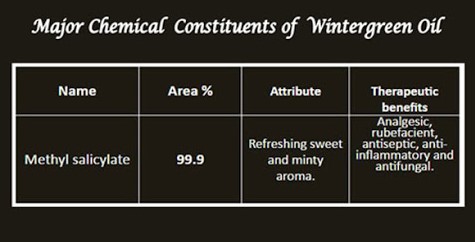
Health benefits of Wintergreen Essential Oil:
Research shows that wintergreen oil has the ability to act like a natural analgesic (pain reducer), antiarthritic, antiseptic and astringent. Wintergreen oil primarily contains the active ingredient methyl salicylate, which makes up about 85 percent to 99 percent of wintergreen essential oil.
It’s one of the best sources of this inflammation-fighting compound in the world and believed to be one of only several plants that naturally supply enough to form an extract. Birch essential oil also contains methyl salicylate and therefore has similar tension-reducing benefits and uses.
Wintergreen is absorbed into skin quickly and acts like a natural numbing agent, similar to cortisone. It also promotes blood circulation and cools irritation, which is comforting to swollen skin. Additionally, wintergreen also contains antioxidants and beneficial ingredients, including guaiadienes, a-pinene, myrcene, delta 3-carene, limonene and delta-cadinene.

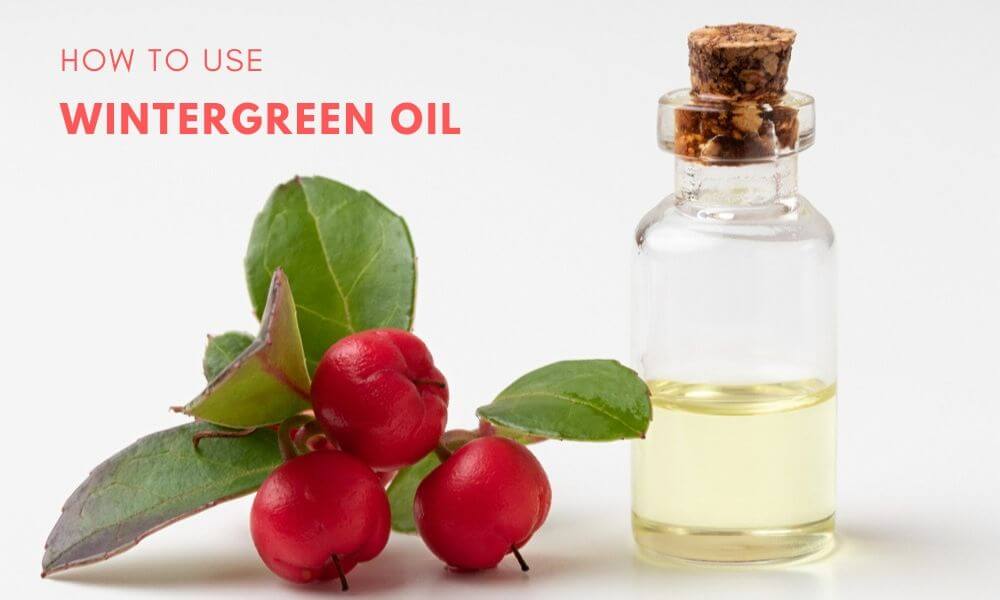
1. Muscle Pain Relief
Ever try a pain-relieving muscle rub that smelled like menthol or mint? Chances are the product included peppermint or wintergreen oils because both are considered “counterirritants.” Wintergreen oil works to reduce swelling and irritation that occurs around painful muscle, tissue and joints. Several drops massaged into the skin is great for relieving achy joints from arthritis or rheumatism. It’s also helpful for treating sore muscles and chronic neck pain, as well as relieving lower back pain.
2. Cold and Flu Treatment
Wintergreen leaves contain an aspirin-like chemical that can help reduce pain, congestion, swelling and fever associated with common illnesses. To open your nasal passages and breathe more deeply, combine wintergreen and coconut oil together, and than rub them into your chest and upper back just like a store-bought vapor rub.
Other beneficial oils to include in this blend in order to treat or prevent the common cold or flu are eucalyptus, peppermint and bergamot oils.
3. Antibacterial and Antiviral
Since it helps combat bacterial growth, viruses and fungi, use wintergreen around your home or on your body to remove dangerous contaminants. You can run some through your dishwasher or laundry machine to kill odor-causing bacteria and molds that can linger, or scrub some into your showers and toilet bowls.
4. Digestive Relief
Wintergreen oil can be used in small doses to increase stomach acid and juices that help improve digestion. It’s considered a natural mild diuretic and increases urine production, which can help cleanse the digestive tract and reduce bloating. It also has anti-nausea benefits and soothing effects on the gastric lining and colon because of its ability to reduce muscle spasms, making it a natural remedy for nausea. You can rub a homemade wintergreen oil mixture over your abdomen, stomach and lower back to improve blood flow and prevent cramping or pain.
5. Skin and Hair Treatment
As a natural astringent and antiseptic, when applied directly to the skin with a carrier oil, wintergreen is able to fight inflammation from blemishes and skin disorders. It’s also helpful for clearing up acne since it can be used to kill germs on the skin. You can add one to two drops to your normal face wash or mix it with coconut or jojoba oil to nourish itchy, red, swollen skin. In the shower, use wintergreen oil on your scalp or hair to remove bacteria, greasiness and dandruff while adding a fresh scent — similar to the benefits of coconut oil for hair.
6. Energizer and Fatigue Fighter
Records show that Native Americans used wintergreen leaves to increase stamina, alertness and endurance during exercise since it can help extend respiratory capacity and treat pain, mucus buildup or inflammation. Try inhaling wintergreen and peppermint oil before workouts to increase concentration and wakefulness.
You can also dab some along with a carrier oil on your neck, chest and wrists to fight symptoms of sleepiness or to help overcome chronic fatigue syndrome. And for recovery following a workout, diffusing wintergreen oil with a diffuser or vaporizer can help open up nasal and respiratory passages; improve blood flow; or relive pain associated with muscular, joint or skeletal strains.
7. Soothing Bath Soak
To unwind and relieve muscle tension, applying pure wintergreen oil mixed along with lavender oil to either a warm bath or ice bath serves as a great muscle relaxer.
8. Air Freshener
Since it works as a natural home deodorizer that can help mask foul smells, use wintergreen oil around your home to sensitize the air and surfaces of your bathroom and kitchen. Combine several drops with water in a spray bottle and apply to hard surfaces, appliances, garbage cans and even your toilet bowls.
You can also diffuse wintergreen oil using a diffuser to fill bathrooms with a fresh, minty scent or add several drops to some homemade laundry soap for its deodorizing effects.
9. Hunger and Cravings Reducer
The taste and smell of mint can help reduce cravings and signify satiety, which is why many people find it comforting to chew minty gum after a meal or between meals. If you feel the afternoon munchies coming on or the tendency to overeat, try sniffing wintergreen oil or gargling it in your mouth. You can try applying a couple drops on your temples, chest or clothes, too.
10. Homemade Toothpaste
With its ability to kill odor-causing bacteria and mouth irritants, wintergreen oil is a great addition to homemade (or store-bought) toothpastes.
11. Homemade Mouthwash
Wintergreen not only helps naturally freshen your breath, it can also protect gums and teeth from infection and pain. Add one to two drops to water and gargle in your mouth for 30–60 seconds before rinsing.
12. Natural Flavor Enhancer
In commercial food and beverage manufacturing, wintergreen is used as a natural flavoring agent in certain minty-tasting foods, candies and teas. One way to use some at home is to simply add one to two drops to your favorite green smoothie recipes to cut the taste of bitter greens. You can also make homemade mint tea by adding one to two drops to warm water, which improves digestion and helps relieve bloating after a big meal.

Potential Wintergreen Oil Side Effects and Interactions
High doses can be toxic and even painful, so avoid overconsuming wintergreen oil or applying it directly to skin. Use very small quantities of wintergreen oil, especially if you are new to trying it. Also be careful to keep it away from your eyes, the mucus membranes inside of your nose, pets and babies. Because methyl salicylate can be harmful when used on open wounds, internally, on babies or children, and on anyone with allergies, use caution and start slowly.
If you have sensitive skin, there’s a chance you can react badly to mint oils and might experience redness, burning and swelling, so do a small patch test first to make sure you don’t experience any side effects. Try testing one to two drops on an area of your skin that isn’t sensitive, such as your feet or calves. Make sure you can tolerate wintergreen oil well before using it internally or on larger parts of your body.
Avoid using wintergreen oil internally unless you’re working with a professional. Ingesting it can possibly cause side effects for some that include heartburn, flushing, mouth sores, headaches, rashes and acid reflux. Some prescription medications and over-the-counter medications can also adversely interact with wintergreen when it’s consumed, so speak with your doctor if you take any digestive or asthma medications, blood thinners, pain medication, or anti-coagulants.

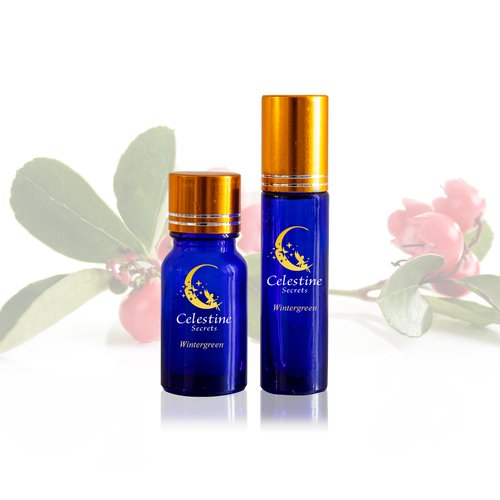






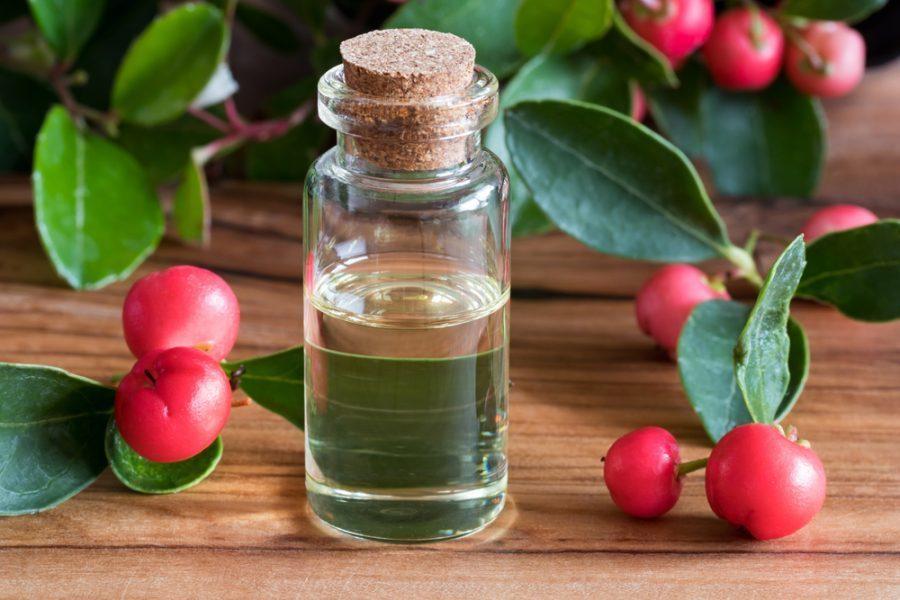

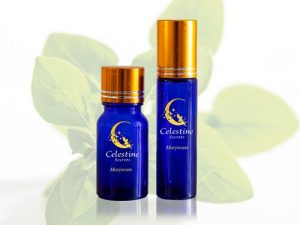

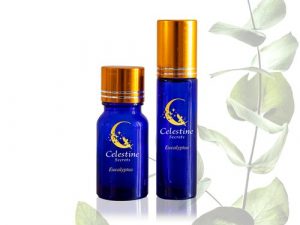
Reviews
There are no reviews yet.